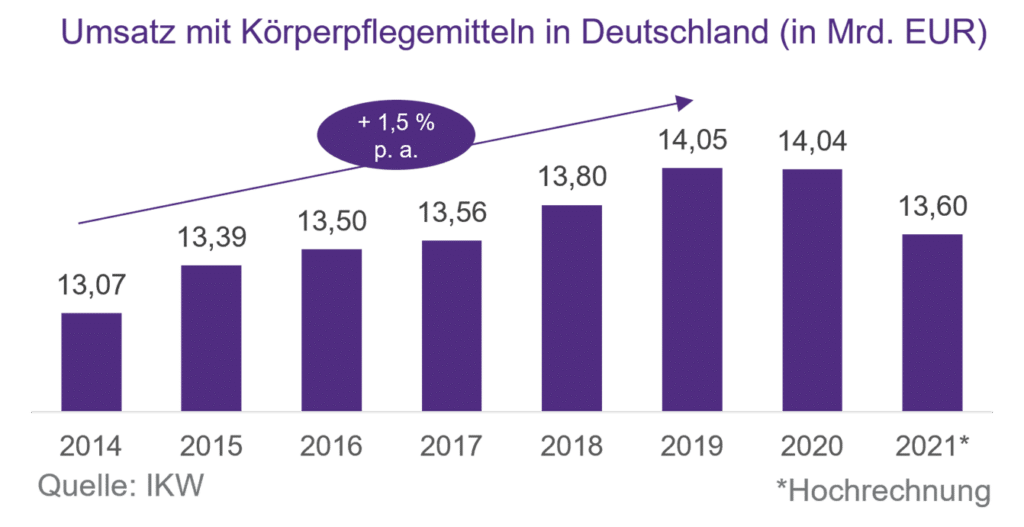After a series of growth years, Germany’s cosmetics sector recorded declining sales in the wake of the 2021 corona pandemic. According to the German Cosmetic, Toiletry, Perfumery and Detergent Industry Association (Industrieverband Körperpflege- und Waschmittel, IKW), for example, around EUR 13.6 billion was spent on personal care products, compared with around 3% more in the previous year.
The corona pandemic has significantly changed consumer behavior in Germany, and this has naturally also affected the cosmetics industry.
While in 2020 there was a massive increase in hygiene products such as soap, in 2021 it was “Home Sweet Home” – everything that makes life in one’s own home more comfortable was particularly in demand. According to IKW, sales of bath and shower additives, for example, had never been as high as in 2021. However, the “wellness at home” trend came at the expense of “beauty away from home.” Thus, there was again a significant decline in demand for decorative cosmetics (-7.2%) and facial care products (-2%). There were also declines in women’s fragrances (-5.6%) and hair care products (-2.4%).
In addition, the effects of the pandemic – in particular the lockdowns – caused significant shifts in terms of distribution channels. Approximately 51% of personal care products were sold in drugstores open throughout 2021 (up 2.2%). In addition, the growth of online retailing accelerated – its share in Germany now exceeds 22% (+ 5.1 pp).
For 2022, the IKW then expects at least a small recovery of 1.8 % in sales volume in the wake of the relaxation of the Corona measures.

But what measures has the industry taken in response to the changed environment? Which success factors will be able to play a special role in the future?
The HANSE research department analyzed the current developments of the market in the course of a project in the HANSE Group and determined:
On the one hand, the pandemic was a driver and accelerator for imperative omni-channel strategies on the part of retail partners. According to the German Cosmetics Association (VKE), brands have also taken advantage of their opportunities to optimize customer experience. In addition, according to the market research company npd Group, innovative campaigns and brand-building initiatives will become more relevant in the online business in the future in order to maintain the brand image and long-term growth. But brick-and-mortar stores also continue to play an important role – beauty is an experience category and consumers enjoy testing products in the store. They are not just focusing on price. This year, the industry is challenged more than ever to ensure the category adds value through new and safe beauty in-store experiences.
One of the central questions continues to be: what does the customer want today and, above all, tomorrow?
On the consumer side, two different main trends are emerging, according to market research company IBIS World. On the one hand, during digitization and the increasing use of social media, the striving for external perfection will continue to grow, especially among young consumers. On the other hand, increasing health and environmental awareness is promoting the importance of naturalness and authenticity in parallel.
What other trends will have a lasting impact on the cosmetics industry in the future?
Various industry experts have identified the following topics as critical to success:
The requirements for sustainability have increased even further in the wake of the Corona pandemic, according to opinion research company Mintel. Water-free, recyclable formats, upcycling, refillable packaging, vegan products and carbon neutrality: the innovations and approaches of manufacturers are diverse.
- Fair consumption – Modern consumers are ever-connected and increasingly informed, staying true to their principles despite an enticing array of choices. Commitment to social and environmental issues and transparent communication are essential.
- Nature meets high-tech – As an evolution of the natural cosmetics trend, synthetic substitutes for animal substances are gaining in importance and also appeal to the growing target group of vegans.
- Diversity and inclusion – The time when any blemishes were hidden is currently a thing of the past. Corners and edges such as freckles, pigment spots and wrinkles prove personality and are advantageously staged with make-up.
- Healthification – In addition to the beauty aspect, products should also promote health and well-being and have a holistic effect on body and mind.
In addition, the so-called Generation Z is increasingly becoming the focus of manufacturers and is seen as the driving force behind the transformation of the cosmetics industry. Born around the turn of the millennium, adolescents and young adults have grown up with the Internet and information technologies, have a pronounced social and environmental awareness, and are shaping the product launches and brand positioning of tomorrow with their purchasing decisions.
What developments do you see in this market in the future?
With best regards
Your HANSE Interim Management
Andreas Lau and Christian Heuermann


